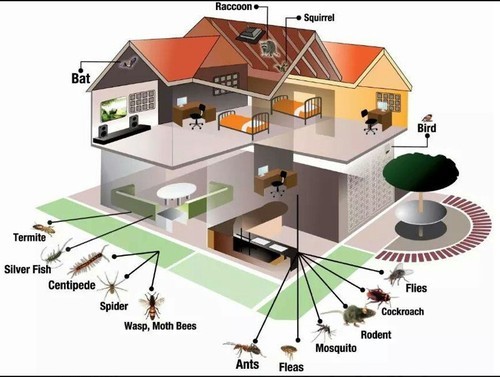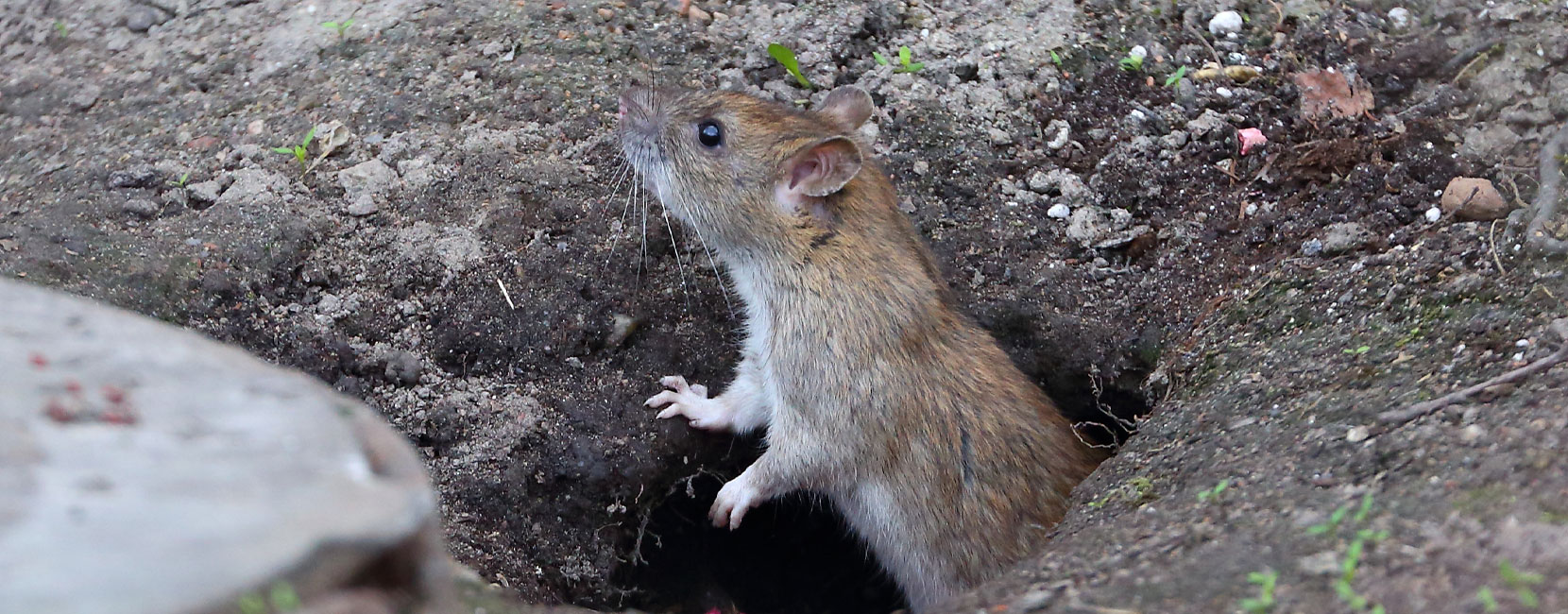
What is Integrated Pest Management (IPM)?
Gone are the days of the pest control man coming into your house and spraying all the baseboards inside your house. Quite simply, there are better ways to do things. Although pesticides that are used today are safer than they have ever been, the push to become less dependent upon chemicals is increasing. Unnecessary pesticide exposure to people and pets is on the forefront of our minds, in addition to the implications for non-target animals and the environment. In many cases, baseboard spraying doesn’t even work because that is not where insects typically spend much time. Thankfully, between scientific advancements on the chemical side and new methodologies of solving pest problems, Pest Management Professionals are solving pest problems more efficiently and completely than in years past and having less impact on the environment.
This new methodology is called Integrated Pest Management, or IPM. IPM is not a single pest control method but, rather, a series of pest management evaluations, decisions, and controls. In practicing IPM, people who are aware of the potential for pest infestation follow a four-tiered approach. The proper practice of IPM elevates the Pest Management Professional to a well trained and experienced tradesman. IPM requires a working knowledge of insect biology, chemistry, construction trends, and many other fields of study that intersect with your particular pest control problem. For example, applying a targeted roach bait to harborages (where roaches live and breed) will have much greater success than spraying baseboards ever will.
Principles of Integrated Pest Management (IPM)
IPM is an environmentally sensitive approach to solving difficult pest problems. IPM recognizes that not every insect sighting requires a pesticide application. IPM stresses the importance of knowing the pest insect, their life cycle, and their habits. Using this knowledge and applying it to the structure that is affected in a thoughtful and systematic way, you may be able to prevent pests from entering the home in the first place, thus eliminating the need to spray. When any control action is taken, the results are monitored, and changes are made if necessary. IPM requires good communication between the homeowner and the Pest Management Professional. Ultimately, pest control is often achieved with little pesticide used, and seldom is indoor spraying necessary.
Set Action Thresholds for Bugs
Setting an action threshold is simply the idea that not every insect sighting should be actionable. For example, seeing an ant walking through the grass, 100 feet from your home, should not necessarily trigger a full yard ant treatment. However, multiple fire ant mounds and complaints of fire ant stings, should initiate action.
Some people’s threshold for pests is lower than others. A native to South Florida, may expect to see an occasional palmetto bug in their house and thus choose not to take action when a flying roach is sighted. However, a recent transplant to South Florida, may demand a complete eradication of these large flying roaches. A commercial kitchen or restaurant should have a very low tolerance for roaches and flies, as their ability to remain open and in business depends upon near perfect inspections.
Through effective communication and education, the Pest Management Professional can help to set realistic pest expectations given the geographic location, time of year, and other factors. If the number of pests observed, is minimal enough so as not to be a concern, focus should remain on prevention rather than chemical treatments. If the quantity of insects is above the threshold that can be tolerated, you should move on to the next step of IPM.
Inspect, Identify, and Monitoring Pests

The hallmark of a properly trained IPM technician is their ability to thoroughly and completely inspect a home for a pest infestation. Whether the complaint is ants, roaches, termites, or rodents, an inspection is the key that guides the next steps. The initial inspection also acts as a baseline which helps to determine if any of the control measures have been effective.
A properly executed pest inspection can take time. The technician should be looking for both live pests, and evidence of pests, such as fecal droppings, shed exoskeletons and wings, even recognizable odors. During the inspection, the technician should be looking for conducive conditions, such as leaking pipes, food in your teenager’s bedroom, and holes and gaps through which insects and rodents may enter. During this inspection, the Pest Management Professional may be able to identify, down to the species, the exact kind of ant or roach you are battling. This is important because different species of ants and roaches behave differently. If you try to treat a primarily outdoor roach the same as an indoor roach, the treatment will be ineffective. Your Pest Management Professional will apply their knowledge of nesting habits, life cycle and rates and timing of reproduction, and food preferences to help solve the pest problem in your home.
Consistent monitoring for pests is another characteristic of proper IPM technique. During a pest inspection, your technician may place small sticky traps around your home. These are dated and noted where they were located and placed in inconspicuous areas such as behind the toilet, under sinks, or inside drawers or cabinets. These insect monitors are pesticide free. They act as your eyes 24 hours a day. They can tell you if a German roach infestation is limited to the kitchen or if they are thriving in the bathrooms and bedrooms as well. Monitoring should continue during and after treatment. Ongoing pest monitoring will tell you how effective the treatments are and identify early outbreaks of future infestations.

Pest Prevention
A simple, basic, and often overlooked aspect of controlling pests, is simply preventing them from coming indoors. In Integrated Pest Management language this is often called Physical Control. By physically blocking the pest from entering the premises, you are exerting a physical control mechanism. Sometimes solving a roach problem is as simple as installing door sweeps or repairing damaged window screens. Do not underestimate insects’ ability to squeeze through the tiniest access hole. By properly sealing your home, you can prevent rats, mice, other wildlife, roaches, and other unwelcome visitors.
Another IPM friendly way to prevent pests is with general sanitation. Insects congregate where food, water, and shelter are abundant. By working to remove these conducive conditions, you can prevent pests from becoming a problem. Outdoors, reduce leaf and branch clutter, close the lids on garbage cans and compost bins, and repair leaky faucets to prevent moisture issues. To prevent mosquitoes, do not allow any standing water on your property. Indoors, wipe up spills as soon as they occur, and take the garbage out on a regular schedule. Clean trash pails and contain all food to the kitchen and dining room. Clean the kitchen after each meal, create a schedule for wiping down cabinets and the pantry. By proactively keeping your home tidy, you can prevent a myriad of insects from making pests of themselves.
IPM Control Methods
If additional control measures are needed to solve a pest control issue, Integrated Pest Management supports mechanical and physical control before resorting to chemical control. Examples of physical or mechanical control include using a rat trap rather than rodent bait. Physical control may also be utilizing a HEPA Filter vacuum cleaner to suck up flies from inside your home, rather than chasing them down with spray. Another example of physical or mechanical insect control is the use of steam or freezing temperatures to kill bed bugs. Often in severe German roach infestations, vacuuming the roach hiding spots can immediately reduce the level of infestation.
Sometimes, pest problems must be dealt with using the help of chemical control. Baits are preferrable to liquid sprays. Baits can be more precisely applied to target the pest population, and often they work better. Many baits are designed to kill the insect’s slowly which allows the insect that has consumed the bait to take it back to the nest where it is spread to the others. Environmentally friendly baits are effective for infestations of ants, roaches, and even some species of termites.
Another chemical product that is considered IPM approved and environmentally friendly, is the use of Insect Growth Regulators, or IGRs. IGRs are not pesticides because they do not kill the insect. Rather, IGRs help to control insect populations because they prevent insects from being able to reproduce. Some insects have astounding reproductive capacity, and these products give us an edge in the battle against bugs.
The final line of defense according to IPM protocols is spraying a liquid concentrate, especially spraying indoors. IPM does not forbid the use of pesticide sprays. They should be used with restraint, only when necessary, and the proper chemical for the job should be chosen by a trained and knowledgeable person. The chemical application should only be applied in areas where your monitoring tells you that there is an ongoing pest issue. Targeted pesticide applications, especially outdoors, are an essential tool in the toolbelt of the Pest Management Professional, but blanket spraying a home is outdated and unnecessary.
Evaluate Your Pest Control Treatment
The final step of an IPM program is the constant evaluation of the treatments. By monitoring the results of a treatment, you know if it is working or not. If you are catching more German roaches on your insect monitors now, than before you treated, you know that you need to make changes. Perhaps the roaches are resistant or averse to the bait that you have offered. Perhaps the bait locations were tainted by sprays prior to your placing the bait down. Or perhaps there is an access location that you haven’t found yet. By continually monitoring the success of your efforts, and making changes when necessary, you will find success following IPM procedures.
Is IPM Natural Pest Control?
The word “natural” means something different to everyone. To some people, a pest control protocol that is certified organic is the only way to be natural. To others, anything less toxic than spraying all the baseboards of your home is natural. IPM does not rely on synthetic pesticides as its first line of defense, but does not completely preclude these products either. There are many weapons that are effective against insects, and IPM practices ensures that all alternatives are exhausted before pesticides are sprayed in and around your home.
Some pest control companies that are quite proficient with IPM practices offer organic programs. If you choose a program like this, IPM practices will be applied, and should any pesticides be used, they will be organic.
What Bugs can be Controlled with IPM?
The principles behind Integrated Pest Management can be applied to any insect situation. The most common pest control complaints are ants and roaches. When IPM practices are followed, there are greater rates of success than when it is not applied. IPM ideals can also be practiced with wildlife issues such as bats, squirrels, and racoons. Most bed bug treatments utilize many physical and mechanical controls as well as chemical controls. While every tenant of IPM may not be applicable in every situation, by thinking about the life cycle and biology of the target insect or pest, you can gain an edge in solving complicated pest problems.
Where Can IPM be Used?
IPM should be utilized in every residential pest control situation, regardless of a person’s sensitivity to chemicals. However, it is invaluable in higher risk situations, such as in schools, nursing homes, and hospitals. Farmers have begun using tenants of IPM and are generating greater yields and using less pesticide. The low-risk solutions offered by IPM can be easily adapted to any industry or circumstance.










